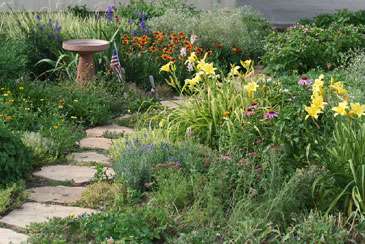Landscaping with a Green Thumb: The Ornamental Garden

In this article, you will find:
The low-maintenance garden
Landscaping with a Green Thumb: The Ornamental Garden
Gardening with your family can be fun, and it can be a great way to teach your kids about nature and the environment. If you'd like to see green plants, flowers, shrubs, and trees in your yard instead of just a broad expanse of lawn, you're on your way to an environmentally friendly landscape. Just be sure to follow "green" practices and opt for a low-maintenance garden. The low-maintenance garden benefits the environment in part because it requires much less water and fertilizer. But it also benefits you, the gardener, because there is far less weeding and dividing of plants to be done.
Plant Shrubs and Small Trees
Shrubs and trees are the major structural elements in an ornamental garden, so purchase and plant them first. Flowering trees such as weeping cherry, dogwood, and redbud provide height and visual interest. In the first year after planting, they should get regular, deep watering. But once they are established, there is little you need to do other than provide mulch at their base.
Shrubs can fill a space nicely, provide privacy, and mark your property lines. They also provide year-round interest. There is a shrub for every situation, from deep shade to full sun. There are evergreens, including flowering evergreens like rhododendron, and there are shrubs with seasonal interest—flowers in the spring, berries and yellow or red leaves in the fall.
Attract Wildlife
Create a yard or garden that will attract a variety of birds and butterflies, and you'll benefit in two ways: You'll have the pleasure of watching them, and the birds will take care of many insect pests, including mosquitoes. To encourage birds to nest and raise their young, your yard will need to provide cover, water, and a varied, long-term food supply.
Deciduous trees and shrubs (those that lose their leaves in the fall) generally bear fruit, nuts, and seeds, and they offer leafy nesting sites in the warm months. Evergreens tend to be a good source of berries and seed-filled cones. They also offer year-round shelter and protection.
Use Mulch
Mulch is a major time-saver in the landscape. It helps reduce water evaporation from the soil around plants, so less watering is required. It also discourages the growth of weeds. You can buy bags of shredded bark, bark chips, and chunk bark mulch at nurseries. To limit the amount of mulch you need to buy, try covering the bare earth with several sheets of newspaper, then hide the newspaper with bark mulch. The newspaper provides a good barrier, but lets water pass through and breaks down over time. You can save yourself money by using natural mulches that may already be available on your property, such as pine needles and leaves. However, you will need to shred these materials to prevent matting, and you may find them less attractive than bark mulch.
The best organic mulch of all is compost, which you can create from kitchen and yard waste. It benefits soil in many ways, and costs you little or nothing.
Organic mulches will decompose over time, adding nutrients and organic matter to the soil. That means they will require some renewing each year, early in the season. Apply the mulch when the soil is reasonably moist, and water it well to help it settle into the bed. Note that you don't need more than two or three inches of mulch, and that you should leave a couple of inches free of mulch at the base of each plant or tree.
Inert mulches such as gravel and pebbles have the advantage of never needing renewal, but they will let weeds through unless you lay down a weed-barrier fabric first. These mulches may also have the effect of heating the soil too much for some plants, especially in direct sun.
Plant Ground Covers
Noninvasive ground covers are another effective and attractive way to prevent weeds. These small plants also provide color, and since they help to hold in moisture, many people plant them at the base of trees and shrubs. Ground covers are also excellent for planting on slopes or areas that are difficult to mow, since they require little or no tending once they are established. You can help them get established by mulching them at planting time with a good shredded bark or compost. Good choices are sweet woodruff, ajuga, lilyturf, pachysandra, and lamium.
There are also popular ground covers that will tolerate some foot traffic, called "steppables," which can be planted near pathways or among stepping stones. These plants include sedums, dwarf mondo grass, creeping jenny, and thyme.

